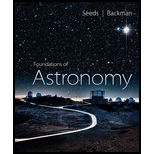
Foundations of Astronomy (MindTap Course List)
14th Edition
ISBN: 9781337399920
Author: Michael A. Seeds, Dana Backman
Publisher: Cengage Learning
expand_more
expand_more
format_list_bulleted
Concept explainers
Question
Chapter 2, Problem 6P
To determine
The magnitude of star B and visible star.
Expert Solution & Answer
Trending nowThis is a popular solution!

Students have asked these similar questions
Consider a rubber rod that has been rubbed with fur to give the rod a net negative charge, and a glass rod that has been rubbed with silk to give it a net positive charge. After being charged by contact by the fur and silk...?
a. Both rods have less mass
b. the rubber rod has more mass and the glass rod has less mass
c. both rods have more mass
d. the masses of both rods are unchanged
e. the rubber rod has less mass and the glass rod has mroe mass
8) 9)
10)
11)
12)
13)
14)
15)
Chapter 2 Solutions
Foundations of Astronomy (MindTap Course List)
Ch. 2 - Why are most of the constellations that were...Ch. 2 - Prob. 2RQCh. 2 - Which is the asterism and which is the...Ch. 2 - Prob. 4RQCh. 2 - Prob. 5RQCh. 2 - What does the word apparent mean in apparent...Ch. 2 - Prob. 7RQCh. 2 - Prob. 8RQCh. 2 - Prob. 9RQCh. 2 - Prob. 10RQ
Ch. 2 - Why doesnt a magnitude difference of one mean that...Ch. 2 - Prob. 12RQCh. 2 - In what ways is the celestial sphere a scientific...Ch. 2 - Is the precessing top shown in Figure 2-7a an...Ch. 2 - How would you define the celestial poles and...Ch. 2 - Where would you need to go on Earth to see the...Ch. 2 - Where would you go on Earth if you wanted to be...Ch. 2 - Your zenith is at your east point and your nadir...Ch. 2 - Why does the number of circumpolar constellations...Ch. 2 - Explain two reasons winter days are colder than...Ch. 2 - How does the date of the beginning of summer in...Ch. 2 - If it is the first day of spring in your...Ch. 2 - It is the first day of summer. Will the days start...Ch. 2 - How much flux from the Sun does the Northern...Ch. 2 - Why does the eccentric shape of Earths orbit make...Ch. 2 - How Do We Know? How can a scientific model be...Ch. 2 - How Do We Know? Why is astrology a pseudoscience?Ch. 2 - How Do We Know? Why must a scientific argument...Ch. 2 - Prob. 1PCh. 2 - Prob. 2PCh. 2 - Prob. 3PCh. 2 - Prob. 4PCh. 2 - Prob. 5PCh. 2 - Prob. 6PCh. 2 - If two stars differ by 8 magnitudes, what is their...Ch. 2 - Prob. 8PCh. 2 - Prob. 9PCh. 2 - By what factor is the full moon brighter than...Ch. 2 - What is the angular distance from the north...Ch. 2 - If you are at latitude 40 degrees north of Earths...Ch. 2 - If you are at latitude 30 degrees north of Earths...Ch. 2 - How many precession periods are in one cycle of...Ch. 2 - Arrange the following in order of increasing...Ch. 2 - Arrange the following in order of increasing...Ch. 2 - Find the Big Dipper in the star trails photograph...Ch. 2 - Look at The Sky Around You, item 1a. In the...Ch. 2 - Look at the view from Earth on March 1 in Figure...Ch. 2 - Look at Figure 2-9, shown here. If you see...
Knowledge Booster
Learn more about
Need a deep-dive on the concept behind this application? Look no further. Learn more about this topic, physics and related others by exploring similar questions and additional content below.Similar questions
- Mick and Rick are twins born on Earth in the year 2175. Rick grows up to be an Earth-bound robotics technician while Mick becomes an intergalactic astronaut. Mick leaves the Earth on his first space mission in the year 2200 and travels, according to his clock, for 10 years at a speed of 0.75c. Unfortunately, at this point in his journey, the structure of his ship undergoes mechanical breakdown and the ship explodes. How old is Rick when his brother dies?arrow_forwardHi, I have canceled, why did you charge me again?arrow_forwardNo chatgpt pls will upvotearrow_forward
arrow_back_ios
SEE MORE QUESTIONS
arrow_forward_ios
Recommended textbooks for you
 Foundations of Astronomy (MindTap Course List)PhysicsISBN:9781337399920Author:Michael A. Seeds, Dana BackmanPublisher:Cengage Learning
Foundations of Astronomy (MindTap Course List)PhysicsISBN:9781337399920Author:Michael A. Seeds, Dana BackmanPublisher:Cengage Learning Stars and Galaxies (MindTap Course List)PhysicsISBN:9781337399944Author:Michael A. SeedsPublisher:Cengage Learning
Stars and Galaxies (MindTap Course List)PhysicsISBN:9781337399944Author:Michael A. SeedsPublisher:Cengage Learning
 AstronomyPhysicsISBN:9781938168284Author:Andrew Fraknoi; David Morrison; Sidney C. WolffPublisher:OpenStax
AstronomyPhysicsISBN:9781938168284Author:Andrew Fraknoi; David Morrison; Sidney C. WolffPublisher:OpenStax Horizons: Exploring the Universe (MindTap Course ...PhysicsISBN:9781305960961Author:Michael A. Seeds, Dana BackmanPublisher:Cengage Learning
Horizons: Exploring the Universe (MindTap Course ...PhysicsISBN:9781305960961Author:Michael A. Seeds, Dana BackmanPublisher:Cengage Learning Stars and GalaxiesPhysicsISBN:9781305120785Author:Michael A. Seeds, Dana BackmanPublisher:Cengage Learning
Stars and GalaxiesPhysicsISBN:9781305120785Author:Michael A. Seeds, Dana BackmanPublisher:Cengage Learning

Foundations of Astronomy (MindTap Course List)
Physics
ISBN:9781337399920
Author:Michael A. Seeds, Dana Backman
Publisher:Cengage Learning

Stars and Galaxies (MindTap Course List)
Physics
ISBN:9781337399944
Author:Michael A. Seeds
Publisher:Cengage Learning


Astronomy
Physics
ISBN:9781938168284
Author:Andrew Fraknoi; David Morrison; Sidney C. Wolff
Publisher:OpenStax

Horizons: Exploring the Universe (MindTap Course ...
Physics
ISBN:9781305960961
Author:Michael A. Seeds, Dana Backman
Publisher:Cengage Learning

Stars and Galaxies
Physics
ISBN:9781305120785
Author:Michael A. Seeds, Dana Backman
Publisher:Cengage Learning